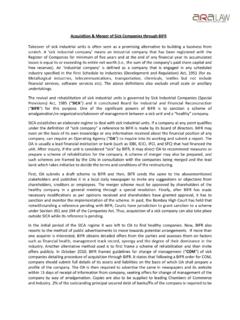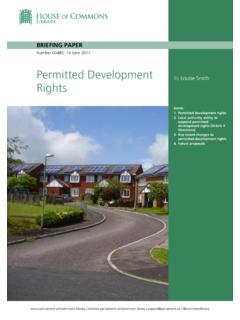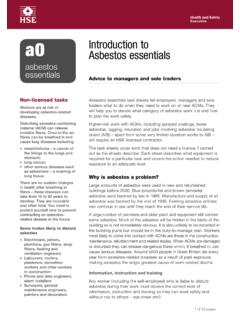Transcription of FOREIGN DIRECT INVESTMENT IN REAL ESTATE I. …
1 1 | P a g e FOREIGN DIRECT INVESTMENT IN real ESTATE I. introduction : significance of FDI in real ESTATE Sector The real ESTATE sector is one of the most critical sectors of the Indian economy due to its huge multiplier effect on the economy. Any impact on the real ESTATE sector has a DIRECT bearing on economic growth. Apart from the well-acknowledged need for FOREIGN investments into this sector because of the sheer demand, the FOREIGN DIRECT INVESTMENT (FDI) route has attracted FOREIGN investors interest in this sector because of the fundamental ban on infusion of funds into this sector by other modes. It is to be noted that use of External Commercial Borrowings (ECBs) and FOREIGN Currency Convertible Bonds (FCCBs) for raising funds for INVESTMENT into real ESTATE has been completely banned.
2 Hence FDI in real ESTATE sector gains prominence. According to DIPP, total FDI inflow in construction development sector during 2000 to 2015 has been around US$ billion which is about 9% of total FDI inflows (in terms of US$). II. Background: Changing Regulatory Scenario The first step towards opening of the real ESTATE sector for FOREIGN investors was taken by the Government of India vide issue of Press Note No. 4 (2001 series)1 by the Department of Industrial Policy and Promotion (hereafter referred to as DIPP ) which permitted FDI up to 100% for development of integrated townships, including housing, commercial premises, hotels, resorts, city and regional level urban infrastructure facilities such as roads and bridges, mass rapid transit systems and manufacture of building. However it was subject to prior FIPB approval.
3 In 2002, DIPP issued Press Note No. 3 (2002 series)2 stipulating other conditions for FDI in development of integrated townships including housing and building material like lock in, minimum capitalization, minimum land requirement, purpose of land usage, completion timings, core business of the entity, etc. The Government approval route was retained. The real boost for FOREIGN INVESTMENT came when the sector was opened up to FDI, with the introduction of DIPP Press Note No. 2, (2005 Series)3. This was done with the object of improving the overall infrastructure of the country as well as to cater to the growing real ESTATE demand in the country. FIPB approval requirement was removed by this step. 1 2 3 2 | P a g e The DIPP through Press Note No.
4 10 (2014 Series)4 and clarifications on Press Note No. 10 (2014 Series)5 introduced extensive amendments to the FDI provisions relating to the construction-development sector. However, certain critical ambiguities still prevailed and the amendments introduced by PN 2014 were counter-productive to the objective which the government intended to achieve. In order to provide further impetus to this sector, the Government of India vide Press Note No. 12 (2015 Series)6 ( 2015 Press Note ) did away with the majority of the onerous conditionalities and announced certain significant relaxations, which are set out below. III. Current Regulatory Position: 2015 Press Note a. FDI in real ESTATE : Permitted: 100% FDI under automatic route is permitted in construction-development projects, which includes development of townships, construction of residential/commercial premises, roads or bridges, educational institutes, recreational facilities, city/regional level infrastructure, townships.
5 Not Permitted: FDI is not permitted in an entity which is engaged or proposed to be engaged in (i) any real ESTATE Business (which is defined and is dealt with below), or (ii) construction of farm houses, or (iii) trading in transferable development rights b. real ESTATE Business: real ESTATE Business has been defined as dealing in land and immovable property with a view of earning income there from and does not include development of townships, construction of residential/commercial premises, roads or bridges, educational institutes, recreational facilities, city/regional level infrastructure, townships. Significantly, the earning of rent or income, not amounting to transfer, from lease of a project in which FDI is permitted would not tantamount to real ESTATE Business . c. Applicable Conditions: Particulars Position under FDI Policy Minimum Capitalization There is no minimum capitalization requirement.
6 [Earlier, a minimum capitalization of USD 5 million was required to be brought in within 6 (six) months of the commencement of the project.] Exit and Lock-in restrictions The investor is permitted to exit from the INVESTMENT : (i) after 3 years from the date of each tranche of FOREIGN INVESTMENT , or (ii) on the completion of the project; or (iii) on the completion / development of trunk infrastructure. The lock-in period of 3 years will also not apply to Hotels & Tourist Resorts, Hospitals, Special Economic Zones, Educational Institutions, Old Age Homes and INVESTMENT by NRIs. Transfer of stake from a non-resident investor to another non-resident investor Transfer of stake by a non-resident investor to another non-resident investor, without any repatriation of INVESTMENT is not subject to any lock-in or prior FIPB approval.
7 Separate Phases/Projects Each phase of a project is considered as a separate project for the purposes of the 4 5 6 3 | P a g e FDI Policy. Minimum Land Stipulation There is no minimum area requirement. Earlier, minimum floor area to be developed under each project was required to be 20,000 sq. meters for construction-development projects. Consequently other requirements applicable before like procurement of empanelled architect by the investee company has also been removed. Completed Assets 100% FDI is permitted under automatic route into completed projects for operation and management of townships, malls/ shopping complexes and business centers. However, there is a lock-in period of 3 years applicable. Transfer of control from residents to non-residents Transfer of control from residents to non-residents as a consequence of FOREIGN INVESTMENT is also permitted.
8 However, there is a lock in period of 3 years applicable and no transfer of immovable property is permitted during this period. Earning or rent/income on lease of the property FDI is not permitted in an entity which is engaged or proposes to engage in real ESTATE Business . However the earning or rent/income on lease of the property, not amounting to transfer, does not amount to real ESTATE Business and hence is permitted. Obligations on Indian Investee company Indian Investee Company is permitted to sell only developed plots, the plots where trunk infrastructure has been available. Indian Investee Company is responsible for obtaining all approvals, payment of development and other charges, and compliance with all other requirements as prescribed by local government bodies. IV. Guidance Notes: a.
9 All FDI conditions are seen on a phase specific basis and hence, so long as the exit criteria for one particular phase is satisfied, FOREIGN investors should be able to exit from their INVESTMENT in that phase. b. An exit option after the lock in period of 3 years is a major relaxation in context of large projects which have not been successful, but the FOREIGN investors wish to exit. Also, FOREIGN investors who had run out of money to develop the trunk infrastructure can now exit post the expiry of the 3 year period. c. The 3 year lock in period should be read along with the real ESTATE Business restriction under capital account regulations. Hence, before achieving an exit, FOREIGN investors must put in all possible efforts to ensure that developers have put their best foot forward to utilize the FOREIGN capital for development purposes.
10 D. Only the INVESTMENT is locked in and not the investor, and hence a non-residents may transfer its shares at any time to another non-resident investor under the automatic route. e. INVESTMENT in completed assets is allowed subject to restriction during the lock in period on any transfers in any manner. The term transfer is defined very wide and covers relinquishment of asset or extinguishment of any right as well. f. The project should confirm to the norms and standards including land use requirements, provision for community amenities, and common facilities as per building control laws, bye laws, rules and regulations of local government body. g. The meaning of the term township is vague and uncertain. Township could mean an urban living area that is not classified as a city. However, townships could exist around large cities.







